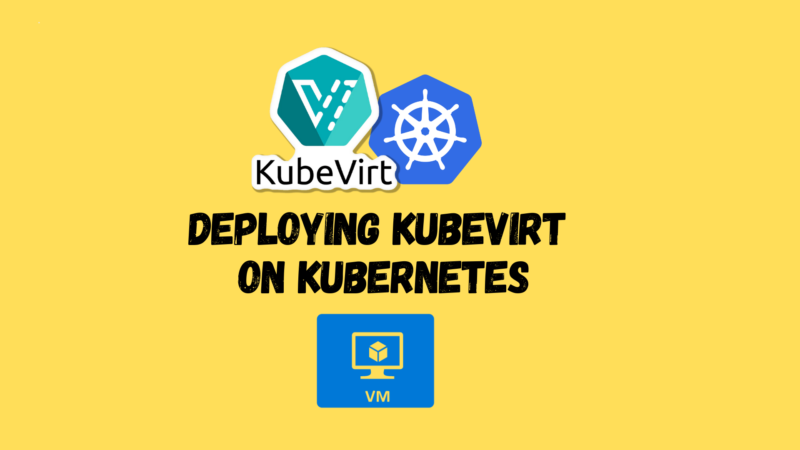Table of Contents Show
Deploy KubeVirt Operator
An Operator is a method of packaging, deploying, and managing a Kubernetes application. A Kubernetes application is one that is deployed on Kubernetes and managed using the Kubernetes APIs and kubectl tooling. You can think of Operators as the runtime that manages this type of application on Kubernetes. If you want to learn more about Operators you can check the Kubernetes documentation
Here, we query GitHub’s API to get the latest available release: (click on the text to automatically execute the commands on the console):
export KUBEVIRT_VERSION=$(curl -s https://api.github.com/repos/kubevirt/kubevirt/releases/latest | jq -r .tag_name)
echo $KUBEVIRT_VERSION
Run the following command to deploy the KubeVirt Operator:
kubectl create -f https://github.com/kubevirt/kubevirt/releases/download/${KUBEVIRT_VERSION}/kubevirt-operator.yaml
Now deploy KubeVirt by creating a Custom Resource that will trigger the ‘operator’ reaction and perform the deployment:
kubectl create -f https://github.com/kubevirt/kubevirt/releases/download/${KUBEVIRT_VERSION}/kubevirt-cr.yaml
Next, we need to configure KubeVirt to use software emulation for virtualization. This is necessary for the course environment but results in poor performance so avoid this step in production environments.
kubectl -n kubevirt patch kubevirt kubevirt --type=merge --patch '{"spec":{"configuration":{"developerConfiguration":{"useEmulation":true}}}}'
Install Virtctl
While we are waiting for the KubeVirt operator to start up all its Pods, we can take some time to download the client we will need to use in the next step.
virtctl is a client utility that helps interact with VM’s (start/stop/console, etc):
wget -O virtctl https://github.com/kubevirt/kubevirt/releases/download/${KUBEVIRT_VERSION}/virtctl-${KUBEVIRT_VERSION}-linux-amd64
chmod +x virtctl
Wait for KubeVirt deployment to finalize
Let’s check the deployment:
kubectl get pods -n kubevirt
Once it’s ready, it will show something similar to:
controlplane $ kubectl get pods -n kubevirt
NAME READY STATUS RESTARTS AGE
virt-api-7fc57db6dd-g4s4w 1/1 Running 0 3m
virt-api-7fc57db6dd-zd95q 1/1 Running 0 3m
virt-controller-6849d45bcc-88zd4 1/1 Running 0 3m
virt-controller-6849d45bcc-cmfzk 1/1 Running 0 3m
virt-handler-fvsqw 1/1 Running 0 3m
virt-operator-5649f67475-gmphg 1/1 Running 0 4m
virt-operator-5649f67475-sw78k 1/1 Running 0 4m
As there are multiple deployments involved, the best way to determine whether the operator is fully installed is to check the operator’s Custom Resource itself:
kubectl -n kubevirt get kubevirt
Once fully deployed, this will look like:
NAME AGE PHASE
kubevirt 3m Deployed
Now everything is ready to continue and launch a VM.
Deploy a Virtual Machine
The command below applies a YAML definition of a virtual machine into the current Kubernetes environment, defining the VM name, the resources required (disk, CPU, memory), etc. You can take a look at the vm.yaml file if you have interest in knowing more about a virtual machine definition:
kubectl apply -f https://kubevirt.io/labs/manifests/vm.yaml
We are creating a Virtual Machine in the same way as we would create any other Kubernetes resource thanks to the KubeVirt operator in our environment. Now we have a Virtual Machine as a Kubernetes resource.
After the vm resource has been created, you can manage the VMs with standard ‘kubectl’ commands:
kubectl get vms
kubectl get vms -o yaml testvm | grep -E 'running:.*|$'
Notice from the output that the VM is not running yet.
To start a VM, use virtctl with the start verb:
./virtctl start testvm
Again, check the VM status:
kubectl get vms
A VirtualMachine resource contains a VM’s definition and status. An instance of a running VM has an additional associated resource, a VirtualMachineInstance.
Once the VM is running you can inspect its status:
kubectl get vmis
Once it is ready, the command above will print something like:
NAME AGE PHASE IP NODENAME
testvm 1m Running 10.32.0.11 controlplane
Access a VM (serial console & vnc)
Now that the VM is running you can access its serial console:
./virtctl console testvm
In environments where VNC client access is available, the graphical console of a VM can be accessed with the virtctl vnc command.
Shutdown and cleanup
As with starting, stopping a VM also may be accomplished with the virtctl command:
./virtctl stop testvm
Finally, the VM can be deleted as any other Kubernetes resource using kubectl:
kubectl delete vms testvm





